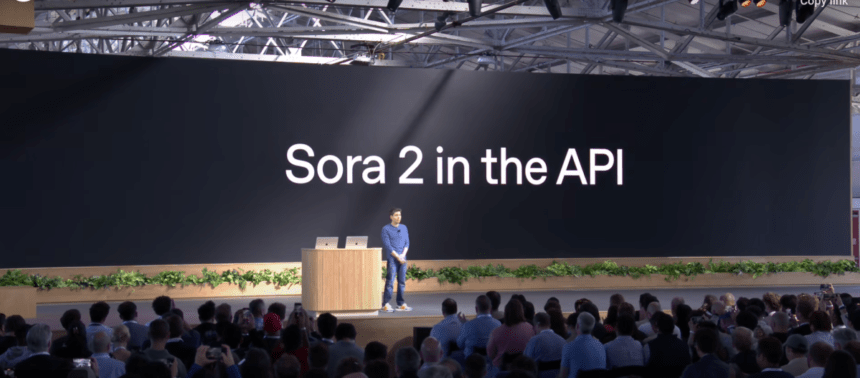OpenAI Unveils Groundbreaking API Updates at Dev Day: A New Era for Developers
OpenAI has made significant strides in artificial intelligence with the recent unveiling of its latest API updates during its Dev Day event. The tech giant introduced several innovative tools, including the highly anticipated GPT-5 Pro, a new video generation model named Sora 2, and a cost-effective voice model. These advancements are designed to enhance the capabilities of developers and expand the applications of AI across various industries.
A Leap Forward: Introducing GPT-5 Pro
At the forefront of OpenAI’s announcements is the introduction of GPT-5 Pro, the latest iteration of its language model. This new model is expected to resonate particularly well with developers in sectors such as finance, healthcare, and legal services, where precision and depth of reasoning are paramount. OpenAI’s CEO, Sam Altman, emphasized the model’s potential to deliver high accuracy, which is crucial for applications that require nuanced understanding and decision-making.
Historically, OpenAI has set a high bar for language models, with previous versions like GPT-3 and GPT-4 already making waves in various applications. The introduction of GPT-5 Pro marks a continuation of this trend, promising even more sophisticated capabilities that could redefine how businesses leverage AI for complex tasks.
Voice Technology: The Future of Interaction
In addition to the advancements in language processing, OpenAI is also focusing on voice technology. Altman highlighted the growing importance of voice as a primary mode of interaction with AI systems. To address this need, OpenAI has launched “gpt-realtime mini,” a smaller and more affordable voice model that supports low-latency streaming interactions. This new model is reported to be 70% cheaper than its predecessor while maintaining the same level of voice quality and expressiveness.
The significance of voice technology cannot be overstated. As seen in the rise of virtual assistants like Amazon’s Alexa and Apple’s Siri, voice interaction is becoming increasingly integral to user experience. OpenAI’s commitment to enhancing voice capabilities positions it well in a competitive landscape where user engagement is key.
Sora 2: Revolutionizing Video Generation
Another highlight of the event was the introduction of Sora 2, OpenAI’s latest audio and video generation model. This tool is designed to empower creators by allowing them to generate high-quality videos based on simple prompts. The Sora app, which accompanies Sora 2, aims to compete with platforms like TikTok by offering a feed of AI-generated short videos.
Altman described Sora 2 as a significant upgrade over its predecessor, featuring more realistic scenes, synchronized sound, and greater creative control. Developers can now access the same model that powers Sora 2’s impressive video outputs, enabling them to integrate these capabilities into their own applications.
The potential applications for Sora 2 are vast. For instance, it can serve as a visual starting point for advertising campaigns or assist designers in transforming sketches into tangible concepts. Altman cited a collaboration with Mattel, the toy manufacturer, as an example of how generative AI can streamline the toy-making process, illustrating the model’s versatility.
Enhanced Creative Control
One of the standout features of Sora 2 is its ability to pair sound with visuals effectively. Altman explained that users can prompt the model to create expansive cinematic shots from simple images, enhancing storytelling through rich soundscapes and ambient audio. This level of creative control is unprecedented in video generation, allowing creators to produce content that is not only visually appealing but also immersive.
The implications of such technology extend beyond entertainment. In fields like education and marketing, the ability to generate engaging video content quickly can transform how information is conveyed and consumed. As businesses increasingly seek innovative ways to connect with their audiences, tools like Sora 2 could become invaluable assets.
A Developer-Centric Ecosystem
OpenAI’s recent updates are part of a broader strategy to cultivate a robust developer ecosystem. By providing tools that enhance creativity and efficiency, OpenAI aims to attract a diverse range of developers to its platform. The introduction of an agent-building tool and the ability to create applications within ChatGPT further underscores this commitment.
The tech landscape is evolving rapidly, and companies that can offer comprehensive solutions to developers are likely to thrive. OpenAI’s focus on empowering creators aligns with a growing trend in the tech industry, where collaboration and innovation are key drivers of success.
Conclusion: A New Chapter in AI Development
OpenAI’s latest API updates represent a significant leap forward in the capabilities of artificial intelligence. With the introduction of GPT-5 Pro, the cost-effective voice model, and the innovative Sora 2, the company is positioning itself as a leader in the AI space. These advancements not only enhance the tools available to developers but also open new avenues for creativity and interaction.
As industries continue to embrace AI, the potential applications of these technologies are vast and varied. OpenAI’s commitment to fostering a developer-friendly ecosystem will likely play a crucial role in shaping the future of AI, making it an exciting time for both creators and consumers alike.











